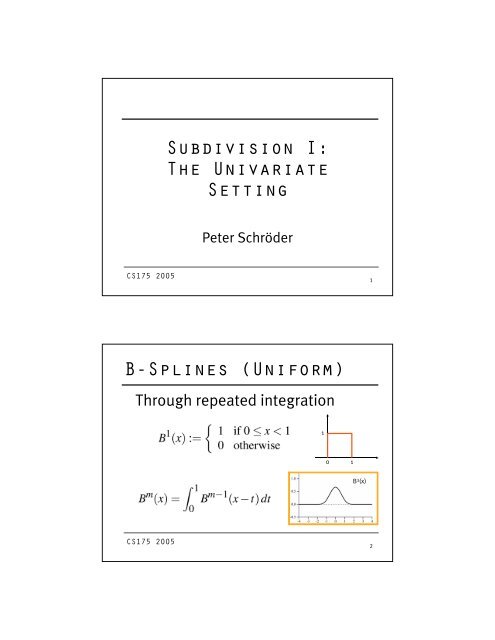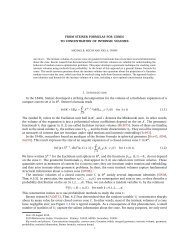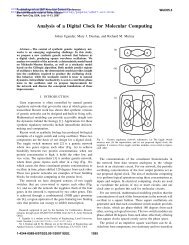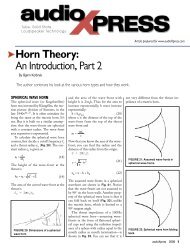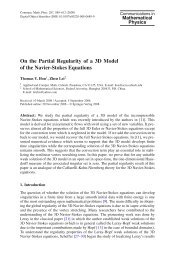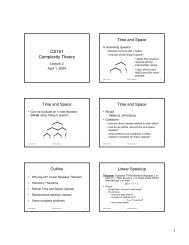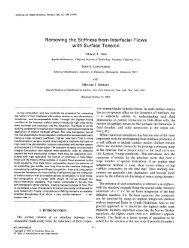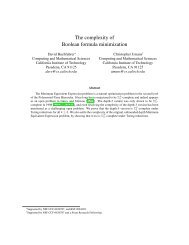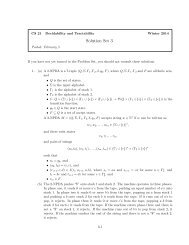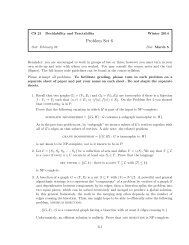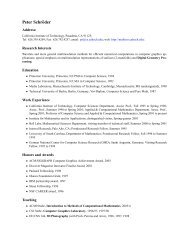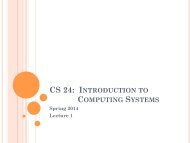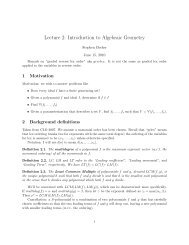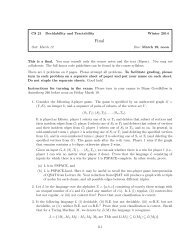Subdivision I: The Univariate Setting B-Splines (Uniform)
Subdivision I: The Univariate Setting B-Splines (Uniform)
Subdivision I: The Univariate Setting B-Splines (Uniform)
Create successful ePaper yourself
Turn your PDF publications into a flip-book with our unique Google optimized e-Paper software.
<strong>Subdivision</strong> I:<strong>The</strong> <strong>Univariate</strong><strong>Setting</strong>Peter SchröderCS175 20051B-<strong>Splines</strong> (<strong>Uniform</strong>)Through repeated integration101B 3 (x)CS175 20052
B-<strong>Splines</strong>Obvious properties piecewise polynomial: unit integral: non-negative: partition of unity: support:CS175 20053B-<strong>Splines</strong>Repeated convolution box functionxCS175 20054
ConvolutionReminder definition: translation: dilation:CS175 20055Refinability IB-Spline refinement equation a B-spline can be written as a linearcombination of dilates andtranslates of itself example linear B-spline and all others…11/2 1/2CS175 20056
Refinability IIRefinement equation for B-splines take advantage of box refinementCS175 20057RefinabilityCS175 20058
B-Spline RefinementExamples1 2( 1, 2, 1)1 8 ( 1, 4, 6, 4, 1)CS175 20059Spline Curves ISum of B-splines curve as linear combinationcontrol pointsCS175 200510
Refinement of CurvesLinear operation on control points succinctlyCS175 200513Refinement of CurvesBases and control pointsCS175 200514
<strong>Subdivision</strong> OperatorExample cubic splinesCS175 2005⎛ΟΜ Μ Μ Μ Ο ⎞⎜⎟⎜Λ1 0 0 0 Λ ⎟⎜Λ⎜4 0 0 0 Λ ⎟⎟⎜Λ6 1 0 0 Λ ⎟⎜⎜Λ 4 4 0 0⎟Λ⎟⎜Λ1 6 1 0 Λ ⎟1 ⎜⎟S = ⎜Λ0 4 4 0 Λ8⎟⎜Λ0 1 6 1 Λ ⎟⎜⎟⎜Λ0 0 4 4 Λ ⎟⎜Λ⎜0 0 1 6 Λ ⎟⎟⎜Λ0 0 0 4 Λ ⎟⎜⎟⎜Λ 0 0 0 1 Λ⎟⎝ΟΜ Μ Μ Μ Ο ⎠1 8( 1, 4, 6, 4, 1)15<strong>Subdivision</strong>Apply subdivision to control points draw successive control polygonsrather than curve itselfCS175 200516
Summary so far<strong>Splines</strong> through refinement B-splines satisfy refinement eq. basis refinement corresponds tocontrol point refinement instead of drawing curve, drawcontrol polygon subdivision is refinement of controlpolygonCS175 200517AnalysisSetup polygon mapped to polygon finite or (bi-)infinite, p ij ∈ R d subdivision operator (linear for now)CS175 200518
<strong>Subdivision</strong> SchemesSome properties affine invariance compact support index invariance (topologicsymmetry) local definitionCS175 200519<strong>Subdivision</strong> OperatorProperties compact support affine invariance index invariance/symmetryCS175 200520
Examples<strong>Splines</strong> linear: quadratic: higher order…CS175 200523ExamplesQuadratic splines Chaikin’s algorithm computes newpoints with weights 1/4(1, 3) and1/4(3, 1) what happens if we change theweights?CS175 200524
ConvergenceHow much leeway do we have? design of other subdivision rules example: 4pt scheme establish convergence establish order of continuityCS175 200525AnalysisSimple facts affine invariance necessarycondition for uniform convergenceCS175 200526
AnalysisConvergence define linear interpolant over givencontrol points and associatedparametric values (knot vector) typically define pointwiseCS175 200527AnalysisConvergence in max/sup norm<strong>The</strong>orem ifthen convergence ofuniformCS175 2005is28
<strong>Uniform</strong> ConvergenceProoflinear spline subdivision operatorCS175 200529Difference DecaySufficient condition continuous limit if analysis by examining associateddifference schemeCS175 200530
ExampleCubic B-splines stencils1/84 41/81 6 1CS175 200531ExampleCubic B-splines differences1/83 11/81 3CS175 200532
Difference DecayAnalysis of difference scheme construction from the subdivisionscheme itselfCS175 200533Higher OrdersSmoothness how to show C 1 ? divided differences must converge check difference of divideddifferences example 4pt schemeCS175 200534
SmoothnessConsequences 4pt scheme: decay estimateCS175 200535Example4pt scheme differences of divided differences1/82 21/8-1 6 -1CS175 200536
AnalysisFundamental solution gives basis functionsCS175 200537Fundamental SolutionProperties refinement relation (why?) support? non-zero coefficients:CS175 200538
So Far, So Good IWhat do we know now? regular setting approximating B-splines interpolating 4pt scheme (Deslaurier-Dubuc)CS175 200539So Far, So Good IIWhat do we know now? differences continuity differentiability not quite general enough current setting assumes a particularparameterizationCS175 200540
More General <strong>Setting</strong>sNon-uniform in spline case better curves subdivision weights will vary knot insertion interpolation⎛a0⎜⎜b0⎜c⎜f⎜dg⎜⎜e hS = ⎜0i⎜⎜0j⎜00⎜⎜00⎜00⎜⎝000 0⎞⎟0 0⎟0 0⎟⎟0 0⎟⎟k 0⎟l 0⎟⎟m p⎟n q⎟⎟o r ⎟0 s⎟⎟0 t ⎠CS175 2005414pt Scheme IWhere do the weights come from? example of Deslaurier-Dubuc given set of samples useinterpolating polynomial to refinesample hereCS175 2005i-1i i+1 i+2Interpolating polynomialfor 4 successive samples42
4pt Scheme IIWeight computation grind out interpolating polynomial resulting weights: 1/16(-1, 9, 9, -1) Deslaurier-Dubuc generalization of same idea higher orders yield higher continuity tends to exhibit “ringing” (as is to beexpected…)CS175 200543Deslaurier-DubucLocal polynomial reproduction choose s k accordingly (d =1 for 4pt) non-uniform possible, increasingsmoothness, approximation power,limit for increasing d is sync fn.CS175 200544
Irregular AnalysisNew tools generating functions not applicable instead: spectral analysis (why?) for irregular spacing only oneparameter: ratio of spacingOn to spectral analysisCS175 200545AnalysisWe need a different approach the subdivision matrix a finite submatrix representative ofoverall subdivision operation based on invariant neighborhoods structure of this matrix key tounderstanding subdivisionCS175 200546
ExampleCubic B-spline 5 control points for 1 segment oneither side of the originSjj+1CS175 200547NeighborhoodsWhich points influence a region? for analysis around a point-1 1CS175 200548
<strong>Subdivision</strong> MatrixInvariant neighborhood which φ(i-t) overlap the origin? tells smoothness storyCS175 200549Eigen AnalysisWhat happens in the limit? behavior in neighborhood of point apply S infinitely many times… suppose S has complete set of EVscontrol pointsin invariantneighborhoodeigen vectorsCS175 200550
<strong>Subdivision</strong> MatrixProperties eigen vectors of non-zero eigenvalues identical proof by extension of y if defective, use generalized eigenvectors and valuesCS175 200551<strong>Subdivision</strong> MatrixEigen vectors and eigen functionsno overbarCS175 200552
Scaling RelationEigen functions scalein neighborhoodof the originCS175 200553Smoothness (at Origin)Lemma for functions which scaleIIIIIICS175 200554
Necessary ConditionsContinuity at eigen functionsCS175 200555Necessary ConditionsSpectrum must be 2 -i for 0 · i · k andcorresponding eigen functionsmust be monomials generalized eigen vectors? λ 0 must be simple?CS175 200556
Sufficient ConditionsCheck at origin eigen functions for |λ| < 2 -k must becheckedCS175 200557<strong>Subdivision</strong> OperatorSpectrum necessary conditions for C k must have λ i =2 -i for i· k eigen functions are polynomials generally not enough 4pt scheme has 1,1/2,1/4,1/4,1/8,-1/16,-1/16 approximation propertiesCS175 200558
ConvergenceLimit position let j go to infinity if λ 0 =1 and |λ i |
More General <strong>Setting</strong>sSubtleties generalized eigen values more subtle smoothness analysis non-uniform subdivision completely irregular subdivision boundaries formule de commutationCS175 200561A NoteSize of subdivision matrix for analysis need enough supportto parameterize a finiteneighborhood of the origin for evaluation need only enoughsupport to zoom in on origin e.g., cubic spline needs 5respectively 3 control pointsCS175 200562
Affine InvarianceSanity condition also necessary for convergenceji1p+ = ∑ sk−k2ipkdisplacement tpj+1i+ t=∑= pkj+1i( p + t)sk−2ik+ ( ∑ s )tk k−2i1 42 43= 1CS175 200563Eigen AnalysisSummary invariant neighborhood tounderstand behavior around point Eigen decomposition of subdivisionmatrix helpful limit point: a 0 , tangent: a 1General setting more complicated...CS175 200564


